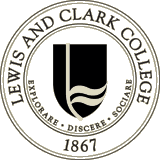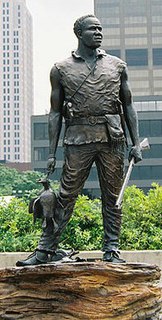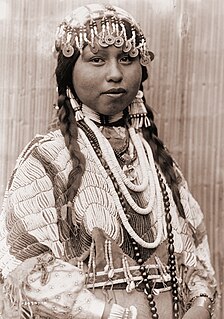Related Research Articles

The Lewis and Clark Expedition from August 31, 1803, to September 25, 1806, also known as the Corps of Discovery Expedition, was the United States expedition to cross the newly acquired western portion of the country after the Louisiana Purchase. The Corps of Discovery was a select group of U.S. Army and civilian volunteers under the command of Captain Meriwether Lewis and his close friend Second Lieutenant William Clark. The expedition made its way westward, and crossed the Continental Divide of the Americas before reaching the Pacific Coast.

Meriwether Lewis was an American explorer, soldier, politician, and public administrator, best known for his role as the leader of the Lewis and Clark Expedition, also known as the Corps of Discovery, with William Clark. Their mission was to explore the territory of the Louisiana Purchase, establish trade with, and sovereignty over the natives near the Missouri River, and claim the Pacific Northwest and Oregon Country for the United States before European nations. They also collected scientific data, and information on indigenous nations. President Thomas Jefferson appointed him Governor of Upper Louisiana in 1806. He died of gunshot wounds in what was either a murder or suicide, in 1809. The Louisiana Purchase was not made official until July 1803, Jefferson still requested Congress to fund the expedition in January of the same year.

William Clark was an American explorer, soldier, Indian agent, and territorial governor. A native of Virginia, he grew up in pre-statehood Kentucky before later settling in what became the state of Missouri. Clark was also a planter and slaveholder.

Lewis & Clark College is a private liberal arts college in Portland, Oregon. Originally chartered in 1867 as the Albany Collegiate Institute in Albany, Oregon, the college was relocated to Portland in 1938 and in 1942 adopted the name Lewis & Clark College after the Lewis and Clark Expedition. Contemporarily, it has an undergraduate College of Arts and Sciences, a School of Law, and a Graduate School of Education and Counseling.

In the nineteenth century, the Oregon Country was a disputed region of the Pacific Northwest of North America. The region was occupied by British and French Canadian fur traders from before 1810, and American settlers from the mid-1830s, with its coastal areas north from the Columbia River frequented by ships from all nations engaged in the maritime fur trade, most of these from the 1790s through 1810s being Boston-based. The Oregon Treaty of 1846 ended disputed joint occupancy pursuant to the Treaty of 1818 and established the British-American boundary at the 49th parallel.

The Clatsop are a small tribe of Chinookan-speaking Native Americans in the Pacific Northwest of the United States. In the early 19th century they inhabited an area of the northwestern coast of present-day Oregon from the mouth of the Columbia River south to Tillamook Head, Oregon.
The Multnomah are a tribe of Chinookan people who live in the area of Portland, Oregon, in the United States. Multnomah villages were located throughout the Portland basin and on both sides of the Columbia River. The Multnomah speak a dialect of the Upper Chinookan language in the Oregon Penutian family.

The Lewis and Clark Centennial Exposition, commonly also known as the Lewis and Clark Exposition, and officially known as the Lewis and Clark Centennial and American Pacific Exposition and Oriental Fair, was a worldwide exposition held in Portland, Oregon, United States in 1905 to celebrate the centennial of the Lewis and Clark Expedition. While not officially considered a World's Fair by the Bureau of International Expositions, it is often informally described as such; the exposition attracted both exhibits and visitors from around the world. During the exposition's four-month run, it attracted over 1.6 million visitors, and featured exhibits from 21 countries. Portland grew from 161,000 to 270,000 residents between 1905 and 1910, a spurt that has been attributed to the exposition.

York was the only African American on the Lewis and Clark Expedition and the first African American to have crossed North America to reach the Pacific.

The Confederated Tribes of the Grand Ronde Community of Oregon (CTGR) consists of twenty-seven Native American tribes with long historical ties to present-day western Oregon between the western boundary of the Oregon Coast and the eastern boundary of the Cascade Range, and the northern boundary of southwestern Washington and the southern boundary of northern California. The community has an 11,288-acre (45.7 km2) Indian reservation, the Grand Ronde Indian Reservation, which was established in 1855 in Yamhill and Polk counties.

The history of Oregon, a U.S. state, may be considered in five eras: geologic history, inhabitation by native peoples, early exploration by Europeans, settlement by pioneers, and modern development.

Comcomly was a leader of the Lower Chinook people located near the present day city of Ilwaco, Washington. Referred to as "Chief" or "'King", a derogatory term, Comcomly in contemporaneous journals,

Eva Emery Dye was an American writer, historian, and prominent member of the women's suffrage movement. As the author of several historical novels, fictional yet thoroughly researched, she is credited with "romanticizing the historic West, turning it into a poetic epic of expanding civilization." Her best known work, The Conquest: The True Story of Lewis & Clark (1902), is notable for being the first to present Sacagawea as a historically significant character in her own right.
Michel Laframboise was a French Canadian fur trader in the Oregon Country who settled on the French Prairie in the modern U.S. state of Oregon. A native of Quebec, he worked for the Pacific Fur Company, the North West Company, and the Hudson’s Bay Company before he later became a farmer and ferry operator. In 1843 he participated in the Champoeg Meetings. Though he voted against the measure to form a provisional government, the measure passed and led to the creation of the Provisional Government of Oregon.

The following works deal with the cultural, political, economic, military, biographical and geologic history of pre-territorial Oregon, Oregon Territory and the State of Oregon.

The Native American peoples of Oregon are the set of Indigenous peoples who have inhabited or who still inhabit the area delineated in today's state of Oregon in the Pacific Northwest region of the United States. While the state of Oregon currently maintains relations with nine federally recognized tribal groups, the state was previously home to a much larger number of autonomous tribal groups, which today either no longer exist or have been absorbed into these larger confederated entities. Six of the nine tribes gained federal recognition in the late 20th century, after undergoing the termination and restoration of their treaty rights starting in the 1950s.
Hoffman Construction Company is a privately held construction founded in 1922. It is headquartered in Portland, Oregon. It also has an office location in Seattle. With a revenue of US$1.4 billion in FY2017, Hoffman was the 4th largest privately held company in Oregon and SW Washington by revenue in FY2017. It was the second largest general contractor in the Portland metro area in April 2019.
Olin Dunbar Wheeler was an American historian, author and topographer.

Tsin-is-tum, also known as Jennie Michel, was a Native American folklorist based on the Pacific Coast of Oregon. Called "Last of the Clatsops" at the time of her death in 1905, Tsin-is-tum was much photographed. She provided oral history for scholars of the indigenous peoples of the Pacific Northwest region of the United States. Among her accounts was of family members who interacted with members of the Lewis and Clark expedition in the winter of 1805-1806; she helped historians to locate salt works they had used.
James P. Ronda is a now retired Western American historian. He is also an emeritus professor of history at the University of Tulsa. During his career, which began at Youngstown State University and finished at the University of Tulsa, Ronda became known for his research on the Lewis and Clark expeditions. He has written multiple works on the subject, as well as appearing on C-Span for a special presentation about the writings of Lewis and Clark, which aired in 2001. Ronda's 1984 book Lewis and Clark: Among the Indians has contributed the most to his reputation as an authority on the subject. Ronda's largest contribution to his field of study was his inclusion of the Native American perspective in the Lewis and Clark expeditions.